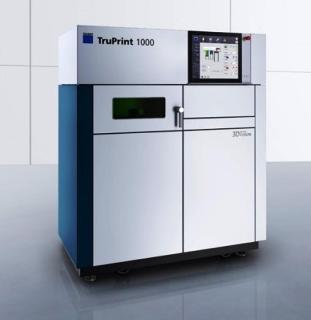Dec 18 2015
German industrial machining and tooling equipment manufacturer, Trumpf, has added another type of metal 3D printing technology to its portfolio.
 TruPrint 1000 LMF 3D printer. Source: 3dprint.com
TruPrint 1000 LMF 3D printer. Source: 3dprint.com
This makes Trumpf the only manufacturer to offer all of the major laser 3D printing technologies. Find out more about all the 3D printing technologies in the IDTechEx master report: 3D Printing 2015-2025: Technologies, Markets, Players.
Their new LMF 3D printer was debuted last month. The new TruPrint 1000 LMF 3D printer works like a selective laser melting 3D printer, using a powder bed process to build three-dimensional parts by laying down a thin layer of metal powder materials onto the build surface while a 200-watt laser fuses the layer of powder along the contour of the part being printed. The technology is capable of fabricating objects with extremely complex geometries not possible with traditional metal manufacturing processes, including objects with internal channels and hollow spaces. The TruPrint 1000 is designed for manufacturing jewellery, dental applications and for materials research. It has a build volume of only 100 mm in diameter and 100 mm tall, making it one of the smallest available metal printers. Information on all the commercially available metal 3D printers can be found in the research report 3D Printing of Metals 2015-2025.
It joins the LMD. In addition to their new LMF metal 3D printer, Trumpf has also introduced new optimized versions of their LMD, blown-powder technology that Trumpf introduced nearly fifteen years ago, to expand its capabilities and speed up the 3D fabrication process.
The additive manufacturing systems are faster than ever before, offer more customization options and can work with a wider range of materials. The improved versions of LMD can deposit material at rates as much as 500 cubic centimeters per hour, and be used to construct entirely new objects, or even to repair or build on top of existing parts.
They are some of the most advanced metal 3D printing technologies available. Both the LMF and LMD technologies are rapidly growing in popularity with businesses and industries that need robust metal 3D printing for rapid prototyping or the manufacturing of low-volume metal parts. All of their technology has been optimized for industrial applications and can be customized for the needs of their individual clients. They will be offering rugged and highly productive machinery for small and medium-sized parts incorporating complex structures, such as injection nozzles, turbine blades, tools or even medical implants. More information on the applications of 3D printing can be found in Applications of 3D Printing 2014-2024: Forecasts, Markets, Players.
Trumpf have recently established a new 3D printing division, headquartered in Ditzingen, Germany. They have been able to build on their core business, which uses similar metal powder materials, but they use them in very different ways. They are expanding their range of metal 3D printing technologies, to be able to offer their customers the widest range of options as possible. Trumpf is offering their customers a complete metal additive manufacturing solution. This includes their high-powered lasers, 3D printing technologies, powder materials, printing services and even application consultation. This is increasingly common in the 3D printing industry, where large companies are adopting a platform approach to provide a complete solution to their customers.